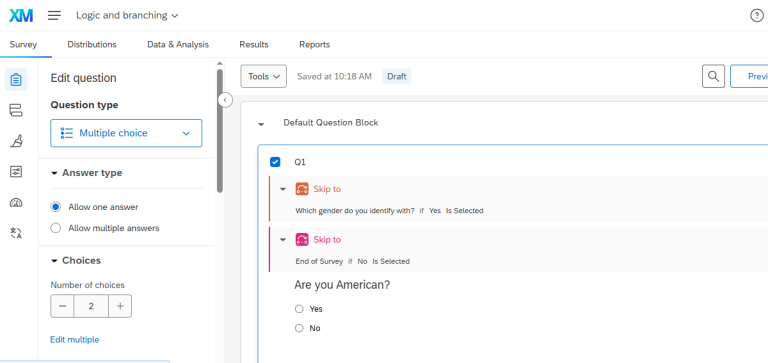Designing a great survey is only half the job. Getting it in front of the right people is what makes the data meaningful. Whether you’re conducting academic research, customer feedback studies, or large-scale public opinion polling, your method of survey distribution directly impacts the reliability, relevance, and completeness of the data collected. In this blog, we break down the most effective survey distribution methods (both online and offline) while guiding you on how to ensure that only your target audience responds and how to increase survey completion when response rates are low.
Online Survey Distribution Methods
1. Email Distribution
One of the most widely used survey distribution channels, email is cost-effective and allows direct targeting. Platforms like Qualtrics, SurveyMonkey, and Google Forms allow you to embed surveys directly or provide secure links.
Tips for Email Distribution: Segment your audience before sending. Personalize the invitation to build trust. Include clear CTAs and deadlines.
2. Social Media Platforms
Leverage the power of platforms like LinkedIn, Facebook, Twitter, and Instagram. Facebook groups and LinkedIn communities allow niche targeting which is ideal for reaching specific professions or interest groups.
Targeted Platforms: LinkedIn – Ideal for professional or B2B surveys. Facebook – Use local groups, interest-based communities, or paid ads. Reddit – Subreddits like r/SampleSize are popular for academic and casual surveys.
3. Survey Exchange Communities
If you’re struggling with reach, communities like SurveyCircle and SurveySwap can help you gain responses by participating in mutual survey exchanges.
4. WhatsApp and SMS Campaigns
For high-engagement rates and quick responses, messaging apps like WhatsApp or traditional SMS work well. They’re particularly useful in areas where email usage is low.
Note: Use shortened URLs and always include consent notices.
5. Website Embeds and Popups
If you have a blog or website, you can embed surveys using tools like Typeform, Jotform, or Microsoft Forms. Exit-intent popups or time-triggered survey prompts can yield valuable user experience data.
6. Paid Online Ads
Use Google Ads or social media ads to reach broader demographics. You can set age, location, interest, and behavior filters to improve targeting.
Offline Survey Distribution Methods
1. Paper Surveys
Still effective in academic, community, and healthcare settings. Use in areas with limited internet access or when a physical signature is needed.
Distribution Tactics: Distribute during events or public meetings. Use drop boxes in clinics, schools, or waiting areas.
2. Telephone Surveys
Often used in market research, telephone surveys offer a personal touch and allow real-time clarification. However, they can be costly and time-consuming.
3. Face-to-Face Interviews
Best suited for qualitative research, especially when targeting small or local populations. Though resource-intensive, they yield high-quality responses.
How to Ensure You Target the Right Respondents
1. Use Screening Questions
Add qualifying questions at the start of the survey to filter out non-target respondents. For example: “Are you a full-time university student?” or “Have you purchased X product in the last 6 months?”
2. Secure Access Links
Generate unique links for specific groups using tools like Qualtrics or SurveyMonkey. Password-protect the survey or use email-based authentication.
3. Use Panel Services
Platforms like Prolific, MTurk, and Dynata offer access to pre-screened, demographically diverse participants.
4. Distribute via Relevant Channels
Don’t blast your survey everywhere. Select channels where your target audience is active. For instance, share a survey on early-stage products in startup Slack groups or Reddit’s r/startups.
How to Improve Survey Response Rates
1. Incentivize Participation
Offering value—whether it’s a gift card, entry into a prize draw, or exclusive access to results—can significantly boost participation. Mention this clearly in your invitation.
2. Optimize Survey Length
Keep it short and focused. Ideally under 10 minutes unless the subject requires depth. Long surveys have high dropout rates.
3. Make It Mobile Friendly
A large portion of respondents use mobile phones. Tools like Typeform and Google Forms are inherently responsive, but always test your survey on multiple devices.
4. Time Your Invitations Well
Avoid weekends or holidays. Send survey invites early in the week and during business hours for B2B audiences.
5. Personalize Follow-Ups
Send reminder emails only to those who haven’t responded. Personalizing follow-ups has shown to increase response rates significantly.
Cost of Survey Distribution and Data Collection
The cost of distributing a survey can vary widely based on method, sample size, and level of targeting. Online distribution is often the most affordable option—email and social media are typically free or low-cost unless you use paid ads or panel services. Platforms like MTurk or Prolific charge per response, with rates starting around $1 per participant, depending on complexity.
Offline methods, such as telephone interviews or paper surveys, tend to be more expensive due to printing, staffing, and logistics. For instance, hiring trained interviewers or purchasing mailing lists can significantly raise costs.
Key cost factors include:
- Survey tool/platform fees: Some tools charge per survey or response.
- Targeting and screening: Narrow demographics cost more to reach.
- Incentives: Monetary or gift rewards for respondents.
- Labor: Especially for phone or face-to-face interviews.
- Analysis and data cleaning: Post-collection processing.
To manage costs effectively, start with a clear sample frame, use digital methods where possible, and match your method to your budget and audience reach goals.
Final Thoughts
Survey distribution plays a pivotal role in the success of any data collection effort. Choosing the right method ensures your results are not only accurate but also actionable. From physical paper forms to AI-assisted targeting on digital platforms, each method has its place depending on your audience, resources, and goals. Most importantly, always ensure your survey reaches the right people and that their experience is engaging and respectful.
Looking for expert support in survey design and distribution? Contact Myspsshelp.com and let us help you collect reliable, high-quality data tailored to your audience.







